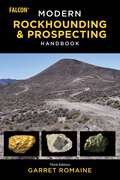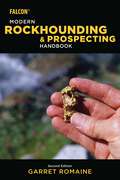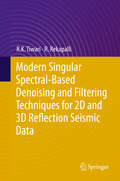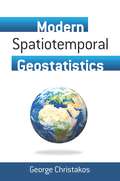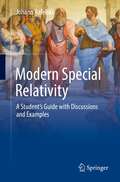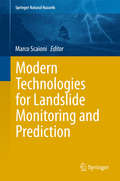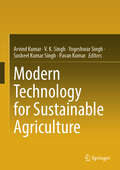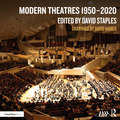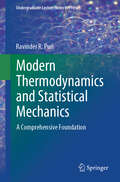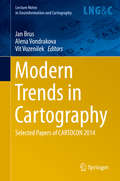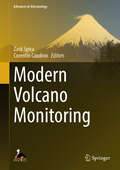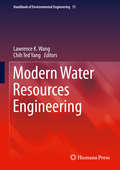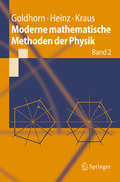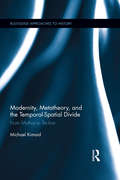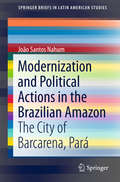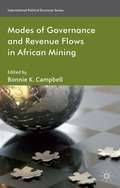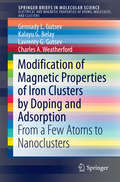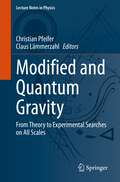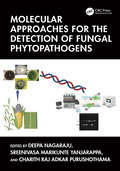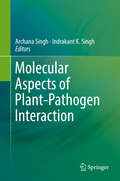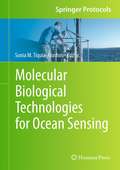- Table View
- List View
Modern Rockhounding and Prospecting Handbook
by Garret RomaineThis volume gives you the basic tools to transition from &“pebble pup&” to expert rockhound and explains everything from geology basics, identification tips, tools of the trade, how to record your findings, and how to set up a lab or gem shop. Before you know it, you&’ll be driving the open roads and traveling home with dusty pockets full of rocks, gems, minerals, fossils—and maybe even gold.Features:* geology basics* popular collectibles, including rocks, gems, fossils, meteorites, and gold* tools of the trade for every level of collector* rules and regulations* polishing, preserving, crafting, and displaying your treasures
Modern Rockhounding and Prospecting Handbook
by Garret RomaineThis volume gives you the basic tools to transition from &“pebble pup&” to expert rockhound and explains everything from geology basics, identification tips, tools of the trade, how to record your findings, and how to set up a lab or gem shop. Before you know it, you&’ll be driving the open roads and traveling home with dusty pockets full of rocks, gems, minerals, fossils—and maybe even gold.Features:* geology basics* popular collectibles, including rocks, gems, fossils, meteorites, and gold* tools of the trade for every level of collector* rules and regulations* polishing, preserving, crafting, and displaying your treasures
Modern Singular Spectral-Based Denoising and Filtering Techniques for 2D and 3D Reflection Seismic Data
by R. K. Tiwari R. RekapalliThis book discusses the latest advances in singular spectrum-based algorithms for seismic data processing, providing an update on recent developments in this field. Over the past few decades, researchers have extensively studied the application of the singular spectrum-based time and frequency domain eigen image methods, singular spectrum analysis (SSA) and multichannel SSA for various geophysical data. This book addresses seismic reflection signals, which represent the amalgamated signals of several unwanted signals/noises, such as ground roll, diffractions etc. Decomposition of such non-stationary and erratic field data is one of the multifaceted tasks in seismic data processing. This volume also includes comprehensive methodological and parametric descriptions, testing on appropriately generated synthetic data, as well as comparisons between time and frequency domain algorithms and their applications to the field data on 1D, 2D, 3D and 4D data sets. Lastly, it features an exclusive chapter with MATLAB coding for SSA.
Modern Spatiotemporal Geostatistics (Dover Earth Science)
by George ChristakosThis scholarly introductory treatment explores the fundamentals of modern geostatistics, viewing them as the product of the advancement of the epistemic status of stochastic data analysis. The book's main focus is the Bayesian maximum entropy approach for studying spatiotemporal distributions of natural variables, an approach that offers readers a deeper understanding of the role of geostatistics in improved mathematical models of scientific mapping. Starting with a overview of the uses of spatiotemporal mapping in the natural sciences, the text explores spatiotemporal geometry, the epistemic paradigm, the mathematical formulation of the Bayesian maximum entropy method, and analytical expressions of the posterior operator. Additional topics include uncertainty assessment, single- and multi-point analytical formulations, and popular methods. An innovative contribution to the field of space and time analysis, this volume offers many potential applications in epidemiology, geography, biology, and other fields.
Modern Special Relativity: A Student's Guide with Discussions and Examples
by Johann RafelskiThis book presents Special Relativity in a language accessible to students while avoiding the burdens of geometry, tensor calculus, space-time symmetries, and the introduction of four vectors. The search for clarity in the fundamental questions about Relativity, the discussion of historical developments before and after 1905, the strong connection to current research topics, many solved examples and problems, and illustrations of the material in colloquial discussions are the most significant and original assets of this book. Importantly for first-time students, Special Relativity is presented such that nothing needs to be called paradoxical or apparent; everything is explained. The content of this volume develops and builds on the book Relativity Matters (Springer, 2017). However, this presentation of Special Relativity does not require 4-vector tools. The relevant material has been extended and reformulated, with additional examples and clarifications. This introduction of Special Relativity offers conceptual insights reaching well beyond the usual method of teaching relativity. It considers relevant developments after the discovery of General Relativity (which itself is not presented), and advances the reader into contemporary research fields. This presentation of Special Relativity is connected to present day research topics in particle, nuclear, and high intensity pulsed laser physics and is complemented by the current cosmological perspective. The conceptual reach of Special Relativity today extends significantly further compared even to a few decades ago. As the book progresses, the qualitative and historical introduction turns into a textbook-style presentation with many detailed results derived in an explicit manner. The reader reaching the end of this text needs knowledge of classical mechanics, a good command of elementary algebra, basic knowledge of calculus, and introductory know-how of electromagnetism.
Modern Technologies for Landslide Monitoring and Prediction
by Marco ScaioniModern Technologies for Landslide Investigation and Prediction presents eleven contributed chapters from Chinese and Italian authors, as a follow-up of a bilateral workshop held in Shanghai on September 2013. Chapters are organized in three main parts: ground-based monitoring techniques (photogrammetry, terrestrial laser scanning, ground-based InSAR, infrared thermography, and GNSS networks), geophysical (passive seismic sensor networks) and geotechnical methods (SPH and SLIDE), and satellite remote-sensing techniques (InSAR and optical images). Authors of these contributes are internationally-recognized experts in their respective research fields. Marco Scaioni works in the college of Surveying and Geo-Informatics at Tongji University, Shanghai (P. R. China). His research fields are mainly Close-range Photogrammetry, Terrestrial Laser Scanning, and other ground-based sensors for metrological and deformation monitoring applications to structural engineering and geosciences. In the period 2012-2016 he is chairman of the Working Group V/3 in the International Society for Photogrammetry and Remote Sensing, focusing on 'Terrestrial 3D Imaging and Sensors'.
Modern Technology for Sustainable Agriculture
by V. K. Singh Arvind Kumar Pavan Kumar Susheel Kumar Singh Yogeshwar SinghModern technology for sustainable agriculture is based primarily on three platforms, namely science, innovation and spatial technologies. These are considered as the three pioneer pillars of nation building. Spatial technologies play a vital role in improving soil quality, reducing the waste of water during irrigation and sharing agricultural information with farmers. With the help of terrestrial, aquatic, and aerial sensors, satellites and surveillance equipment, a large volume of geo-spatial data from diverse sources is collected, analyzed, and utilized for smart farming and shielding of crops. During last five decades, agricultural research and extension has focused on the development of higher productivity of crop varieties, increased fertilizer use and other production technologies. These have enabled the farmers to grow more food, but at the same time it over exploited the resources and resulted in decreasing farm productivity and profitability. To tackle such problems, harmonious use of inputs through integration of various land- based enterprises and their compounded responses needs further attention to make the agriculture more productive, profitable and sustainable. Many technologies have been identified to support sustainable use of resources and facilities, including Natural Resource Management (NRM), Resource Conservation Technologies (RCTs), Integrated Farming System (IFS), Integrated Crop Management (ICM), Integrated Nutrient Management (INM), protected cultivation practices, secondary agricultural practices and post-harvest technologies.
Modern Theatres 1950–2020
by David Staples; David HamerModern Theatres 1950–2020 is an investigation of theatres, concert halls and opera houses in Asia, Europe, the Middle East and North and South America. The book explores in detail 30 of the most significant theatres, concert halls, opera houses and dance spaces that opened between 1950 and 2010. Each theatre is reviewed and assessed by experts in theatre buildings, such as architects, acousticians, consultants and theatre practitioners, and illustrated with full-colour photographs and comparative plans and sections. A further 20 theatres that opened from 2009 to 2020 are concisely reviewed and illustrated. An excellent resource for students of theatre planning, theatre architecture and architectural design, Modern Theatres 1950–2020 discusses the role of performing arts buildings in cities, explores their public and performances spaces and examines the acoustics and technologies needed in a great building.
Modern Theories of Many-Particle Systems in Condensed Matter Physics
by Daniel C. Cabra Andreas Honecker Pierre PujolCondensed matter systems where interactions are strong are inherently difficult to analyze theoretically. The situation is particularly interesting in low-dimensional systems, where quantum fluctuations play a crucial role. Here, the development of non-perturbative methods and the study of integrable field theory have facilitated the understanding of the behavior of many quasi one- and two-dimensional strongly correlated systems. In view of the same rapid development that has taken place for both experimental and numerical techniques, as well as the emergence of novel testing-grounds such as cold atoms or graphene, the current understanding of strongly correlated condensed matter systems differs quite considerably from standard textbook presentations. The present volume of lecture notes aims to fill this gap in the literature by providing a collection of authoritative tutorial reviews, covering such topics as quantum phase transitions of antiferromagnets and cuprate-based high-temperature superconductors, electronic liquid crystal phases, graphene physics, dynamical mean field theory applied to strongly correlated systems, transport through quantum dots, quantum information perspectives on many-body physics, frustrated magnetism, statistical mechanics of classical and quantum computational complexity, and integrable methods in statistical field theory. As both graduate-level text and authoritative reference on this topic, this book will benefit newcomers and more experienced researchers in this field alike.
Modern Theory of Magnetism in Metals and Alloys
by Yoshiro KakehashiThis book describes theoretical aspects of the metallic magnetism from metals to disordered alloys to amorphous alloys both at the ground state and at finite temperatures. The book gives an introduction to the metallic magnetism, and treats effects of electron correlations on magnetism, spin fluctuations in metallic magnetism, formation of complex magnetic structures, a variety of magnetism due to configurational disorder in alloys as well as a new magnetism caused by the structural disorder in amorphous alloys, especially the itinerant-electron spin glasses. The readers will find that all these topics can be understood systematically by means of the spin-fluctuation theories based on the functional integral method.
Modern Thermodynamics and Statistical Mechanics: A Comprehensive Foundation (Undergraduate Lecture Notes in Physics)
by Ravinder R. PuriThis undergraduate-level textbook offers a unique and in-depth approach to the study of thermodynamics and statistical mechanics. It covers the fundamentals of thermodynamics using both traditional and postulatory approaches, including origin of the concept of thermodynamic entropy, Euler’s equation, Gibbs-Duhem relations, stability of equilibrium, and the concept of thermodynamic potentials, and that of independent thermodynamic observables. The book then delves into the microscopic foundation of thermodynamics, starting with the kinetic theory and highlighting its historical development. Boltzmann's concept of entropy is explored, along with its applications in deriving Planck’s, Bose’s, Bose-Einstein, and Fermi-Dirac distribution functions. The formal structure of classical and quantum statistical mechanics is built based on the concept of statistical entropy and the maximum entropy principle and used to investigate in detail the thermodynamic properties of ideal classical and quantum systems. The book also covers phase transitions, simple theory of critical phenomena, and the theory of interacting van der Waals gases. Throughout the text, the book provides historical context, enriching the reader's understanding. This textbook is a valuable resource for undergraduate physics students, offering comprehensive coverage, including overlooked topics, and a historical perspective on thermodynamics and statistical mechanics.
Modern Trends in Cartography
by Jan Brus Alena Vondrakova Vit VozenilekThe fast exchange of information and knowledge are the essential conditions for successful and effective research and practical applications in cartography. For successful research development, it is necessary to follow trends not only in this domain, but also try to adapt new trends and technologies from other areas. Trends in cartography are also quite often topics of many conferences which have the main aim to link research, education and application experts in cartography and GIS&T into one large platform. Such the right place for exchange and sharing of knowledge and skills was also the CARTOCON2014 conference, which took place in Olomouc, Czech Republic, in February 2014 and this book is a compilation of the best and most interesting contributions. The book content consists of four parts. The first part New approaches in map and atlas making collects studies about innovative ways in map production and atlases compilation. Following part of the book Progress in web cartography brings examples and tools for web map presentation. The third part Advanced methods in map use includes achievement of eye-tracking research and users' issues. The final part Cartography in practice and research is a clear evidence that cartography and maps played the significant role in many geosciences and in many branches of the society. Each individual paper is original and has its place in cartography.
Modern Volcano Monitoring (Advances in Volcanology)
by Zack Spica Corentin CaudronThis book describes the different tools that have been developed during the last decades to explain how scientists study volcanoes. It takes into consideration volcanology as being a complex field at the interface between geology, geochemistry and geophysics and provides information about these aspects to embrace the diversity of a volcanic system. The book also provides an outlook to which direction this research is leading. It offers a hands-on experience directly useful if the reader wants to start applying the principles exposed.
Modern Water Resources Engineering
by Lawrence K. Wang Chih Ted YangThe Handbook of Environmental Engineering series is an incredible collection of methodologies that study the effects of pollution and waste in their three basic forms: gas, solid, and liquid. This exciting new addition to the series, Volume 15: Modern Water Resources Engineering , has been designed to serve as a water resources engineering reference book as well as a supplemental textbook. We hope and expect it will prove of equal high value to advanced undergraduate and graduate students, to designers of water resources systems, and to scientists and researchers. A critical volume in the Handbook of Environmental Engineering series, chapters employ methods of practical design and calculation illustrated by numerical examples, include pertinent cost data whenever possible, and explore in great detail the fundamental principles of the field. Volume 15: Modern Water Resources Engineering, provides information on some of the most innovative and ground-breaking advances in the field today from a panel of esteemed experts.
Modern Well Design: Second Edition
by Bernt S. AadnoyModern Well Design - Second Edition presents a unified approach to the well design process and drilling operations. Following an introduction to the field, the second chapter addresses drilling fluids, as well as optimal mud weight, hole cleaning, hydraulic optimization, and methods to handle circulation losses. A relatively large chapter on geomec
Moderne mathematische Methoden der Physik
by Karl-Heinz Goldhorn Hans-Peter Heinz Margarita KrausDer Vorzug des Buchs liegt in der strengen Konzentration auf das Wesentliche. Dabei deckt der Stoff ein breites Spektrum mathematischer Konzepte und Methoden ab und ist so angeordnet, dass er den Bedürfnissen der Studierenden folgt. Neben mathematischen Beweisen, die Studierende mit mathematischer Denkweise konfrontieren, bietet das Lehrbuch Aufgaben, von denen ein Großteil dem Einüben von Rechentechniken dient. Theoretische Aufgaben helfen, Begriffe zu klären und logisches Argumentieren zu üben. Das Glossar enthält alle Definitionen und Sätze.
Modernity, Metatheory, and the Temporal-Spatial Divide: From Mythos to Techne (Routledge Approaches to History #10)
by Michael KimaidThis book is about how modernity affects our perceptions of time and space. Its main argument is that geographical space is used to control temporal progress by channeling it to benefit particular political, economic and social interests, or by halting it altogether. By incorporating the ancient Greek myth of the Titanomachy as a conceptual metaphor to explore the elemental ideas of time and space, the author argues that hegemonic interests have developed spatial hierarchy into a comprehensive system of technocratic monoculture, which interrupts temporal development in order to maintain exclusive power and authority. This spatial stasis is reinforced through the control of historical narratives and geographical settings. While increasingly comprehensive, the author argues that this state of affairs can best be challenged by focusing on the development of "unmappable places" which presently exist within the socio-spatial matrix of the modern world.
Modernization and Political Actions in the Brazilian Amazon: The City of Barcarena, Pará (SpringerBriefs in Latin American Studies)
by João Santos NahumThis book offers an analysis of the territory of Barcarena, in the Brazilian Amazon. The author studies the land use and the implemented modernization policies that made it one of the richest cities of the state. The political system uses this territory as a resource to provide for the needs of a small circle of social agents. A system of conservative political actions enforces the process of modernization of the Baracena territory. Innovations in the Barcarena territory, such as the implementation of the aluminium factory Albras/Alunorte and the territorial configuration or public administration, lead to modernization simulations and artificial devices. The intended effect however is more about appearing to be modern, than actual modernization. The territorial use of Barcarena is aimed to protect the interests and privileges of the elite.
Modes Of Governance And Revenue Flows In African Mining
by Bonnie K. CampbellAcademics, policy-makers and practitioners from Africa and beyond document new ways of thinking about issues concerning governance and revenue flows in mining activities in Ghana, Mali and the Democratic Republic of the Congo.
Modification of Magnetic Properties of Iron Clusters by Doping and Adsorption
by Gennady L. Gutsev Kalayu G. Belay Lavrenty G. Gutsev Charles A. WeatherfordThis brief is based on computations performed on unary neutral and charged iron clusters, binary iron clusters, and iron clusters interacting with carbon and oxygen atoms as well as with a number of diatomics and water. The author considers geometrical structure, thermodynamic stability and electronic properties which are compared with experimental data. Special attention is paid to the dependence of total spin magnetic moments of iron clusters on their size, charge and interactions with dopant and absorbed atoms. In the dopant case, species such as 3d-metal, 4d-metal, Al, and Gd atoms are considered. In the adsorption case interactions of carbon atoms with iron clusters as the initial stage of catalyzed carbon nanotube growth are presented. Interactions of iron clusters with oxygen atoms are presented and the superexchange mechanism is discussed. Of special interest is the tracking of changes due to the evolution from a few atoms to a nanocluster.
Modified and Quantum Gravity: From Theory to Experimental Searches on All Scales (Lecture Notes in Physics #1017)
by Claus Lämmerzahl Christian PfeiferThis book discusses theoretical predictions and their comparison with experiments of extended and modified classical and quantum theories of gravity. The goal is to provide a readable access and broad overview over different approaches to the topic to graduate and PhD students as well as to young researchers. The book presents both, theoretical and experimental insights and is structured in three parts. The first addresses the theoretical models beyond special and general relativity such as string theory, Poincare gauge theory and teleparallelism as well as Finsler gravity. In turn, the second part is focused on the observational effects that these models generate, accounting for tests and comparisons which can be made on all possible scales: from the universe as a whole via binary systems, stars, black holes, satellite experiments, down to laboratory experiments at micrometer and smaller scales. The last part of this book is dedicated to quantum systems and gravity, showing tests of classical gravity with quantum systems, and coupling of quantum matter and gravity.
Molecular Approaches for the Detection of Fungal Phytopathogens
by Deepa Nagaraju Sreenivasa Marikunte Yanjarappa Charith Raj Adkar PurushothamaThis book discusses recent advancements and updates in the molecular diagnostics of fungal phytopathogens. The techniques covered in the seventeen chapters help in understanding the importance of early detection of fungal pathogens and their toxins in both post- and pre-harvest stages of crop production. Molecular Approaches for the Detection of Fungal Phytopathogens describes the fungal identification and isolation from different sources such as food, feed and cereals using molecular approaches. These include variants of polymerase chain reaction (PCR) involving: generic (genus and species) and gene-specific primers, RNA-sequence-based next-generation sequences, microarrays, serial analysis of gene expression, fluorescence in-situ hybridization, loop-mediated isothermal amplification, macroarrays, PCR-denaturing gradient gel electrophoresis, magnetic capture hybridization-PCR, nanotechnology, and immunoassays providing faster and more sensitive approaches than traditional methods that overcome challenges by developing novel disease control strategies.Features Explores various diagnostic strategies for phytopathogens Discusses early detection methods when fungal spores are low or there are no visible symptoms Provides a historical perspective and compares the traditional methods of detection with the current molecular techniques Describes details of the protocol of every technique mentioned Covers point-of-care testing for fungal pathogens and quality assurance for molecular testing in plant health
Molecular Approaches in Natural Resource Conservation and Management
by J. Andrew Dewoody John W. Bickham Charles H. Michler Krista M. Nichols Olin E. Rhodes Keith E. Woeste Jr.Recent advances in molecular genetics and genomics have been embraced by many in natural resource conservation. Today, several major conservation and management journals are now using "genetics" editors to deal solely with the influx of manuscripts that employ molecular data. The editors have attempted to synthesize some of the major uses of molecular markers in natural resource management in a book targeted not only at scientists but also at individuals actively making conservation and management decisions. To that end, the text features contributors who are major figures in molecular ecology and evolution - many having published books of their own. The aim is to direct and distill the thoughts of these outstanding scientists by compiling compelling case histories in molecular ecology as they apply to natural resource management.
Molecular Aspects of Plant-Pathogen Interaction
by Archana Singh Indrakant K. SinghThe book offers an integrated overview of plant–pathogen interactions. It discusses all the steps in the pathway, from the microbe–host-cell interface and the plant’s recognition of the microbe to the plant’s defense response and biochemical alterations to achieve tolerance / resistance. It also sheds light on the classes of pathogens (bacteria, fungus and viruses); effector molecules, such as PAMPs; receptor molecules like PRRs and NBS-LRR proteins; signaling components like MAPKs; regulatory molecules, such as phytohormones and miRNA; transcription factors, such as WRKY; defense-related proteins such as PR-proteins; and defensive metabolites like secondary metabolites. In addition, it examines the role of post-genomics, high-throughput technology (transcriptomics and proteomics) in studying pathogen outbreaks causing crop losses in a number of plants. Providing a comprehensive picture of plant-pathogen interaction, the updated information included in this book is valuable for all those involved in crop improvement.
Molecular Biological Technologies for Ocean Sensing
by Sonia M. Tiquia-ArashiroThe development of ocean sensors remains a ripe area for future investigation from science, policy and systemsengineering standpoints. Clearly, there are many options forrealizing integrated molecular analytical sensing systems. The definition of key target molecules, detection methodsand signal transduction models largely remain to be determined.Moreover, there remains ahuge challenge of merging this new class of instrument with different deployment platforms, and supplying necessarypower and data telemetry infrastructure for their operation. Molecular Biological Technologies for Ocean Sensing features methods papers on the application of ecogenomic sensors on autonomous platforms in the ocean. Topics include the use of ecogenomic sensors as a tool in whole-cell and cell-free based detection and monitoring a suite of pathogens and biotoxins that are of public health concern; documenting species diversity, evolution and metabolic function; identification and quantification of aquatic organisms; and inferring metabolic potential and activities of microorganisms in the ocean. Each contribution focuses on the (1) functional requirements for detecting specific microorganisms and the genes that they harbor and express;(2) examples of research activities that take advantage of molecular detection technologies;(3) some of the challenges faced when projecting development and use of novel instruments that will utilize molecular techniques onboard autonomous platforms;and future directions. Bringing these advancements on autonomous platforms, monitoring required sample collection and processing schemes will differ from those currently used (i.e. biomedical diagnostics). This book is the first of its kind to compile current technologies for studying organisms in situ. It will aid in transfer technology to oceanographers, ecologists, microbiologists, and environmental scientists with needs for a remote, in-water sensing capability and for integration with larger scale observatory operations. With this network in place, there is a potential to bridge the gap among regulatory agencies and academics about how this kind of technology can be used for research and monitoring purposes.
